高一英语必修二第五单元语法教案
- 格式:doc
- 大小:41.50 KB
- 文档页数:5
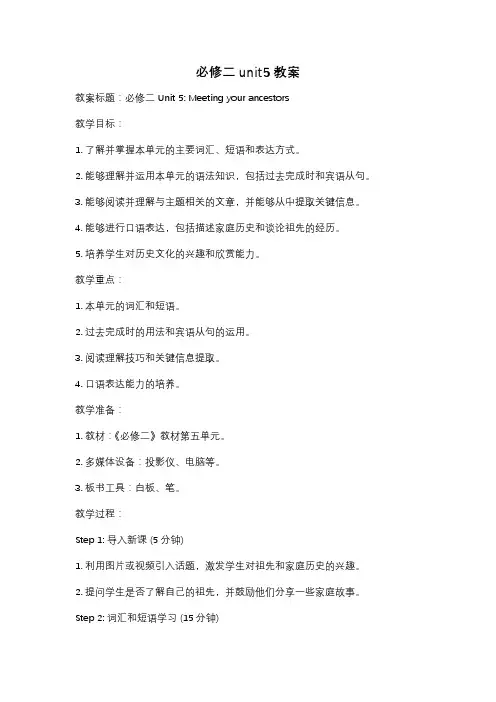
必修二unit5教案教案标题:必修二 Unit 5: Meeting your ancestors教学目标:1. 了解并掌握本单元的主要词汇、短语和表达方式。
2. 能够理解并运用本单元的语法知识,包括过去完成时和宾语从句。
3. 能够阅读并理解与主题相关的文章,并能够从中提取关键信息。
4. 能够进行口语表达,包括描述家庭历史和谈论祖先的经历。
5. 培养学生对历史文化的兴趣和欣赏能力。
教学重点:1. 本单元的词汇和短语。
2. 过去完成时的用法和宾语从句的运用。
3. 阅读理解技巧和关键信息提取。
4. 口语表达能力的培养。
教学准备:1. 教材:《必修二》教材第五单元。
2. 多媒体设备:投影仪、电脑等。
3. 板书工具:白板、笔。
教学过程:Step 1: 导入新课 (5分钟)1. 利用图片或视频引入话题,激发学生对祖先和家庭历史的兴趣。
2. 提问学生是否了解自己的祖先,并鼓励他们分享一些家庭故事。
Step 2: 词汇和短语学习 (15分钟)1. 使用多媒体展示本单元的主要词汇和短语,并进行解释和示范。
2. 进行词汇和短语的练习,包括词义理解、句子搭配等。
Step 3: 语法学习 (15分钟)1. 介绍过去完成时的用法和构成,并与现在完成时进行对比。
2. 提供一些例句进行讲解和练习,确保学生理解并能正确运用过去完成时。
Step 4: 阅读理解 (20分钟)1. 分发阅读材料,要求学生在规定时间内阅读并回答问题。
2. 引导学生使用扫读和略读的技巧,帮助他们从文章中提取关键信息。
3. 检查学生的答案,并进行讨论和解释。
Step 5: 口语表达 (15分钟)1. 提供一些与家庭历史和祖先经历相关的问题,要求学生进行小组讨论。
2. 鼓励学生分享自己的观点和经历,并引导他们使用过去完成时和宾语从句进行表达。
Step 6: 小结和作业布置 (5分钟)1. 复习本节课所学的重点内容,并提醒学生注意复习。
2. 布置相关的作业,包括完成练习题、写一篇关于自己祖先的短文等。
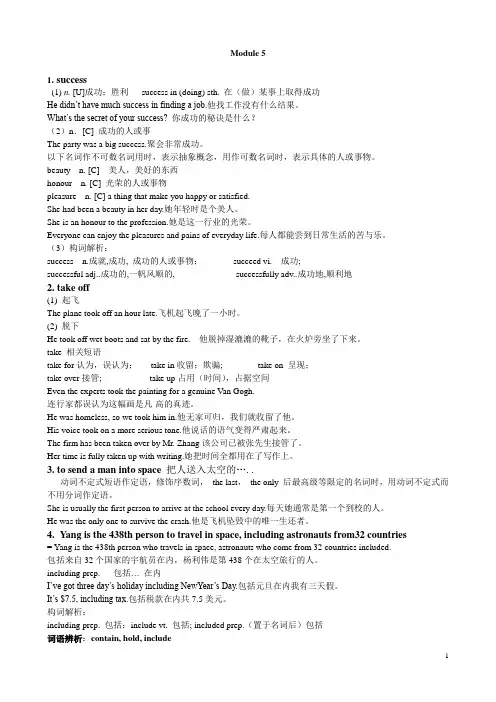
Module 51. success(1) n. [U]成功;胜利success in (doing) sth. 在(做)某事上取得成功He didn’t have much success in finding a job.他找工作没有什么结果。
What’s the secret of your success? 你成功的秘诀是什么?(2)n.[C] 成功的人或事The party was a big success.聚会非常成功。
以下名词作不可数名词用时,表示抽象概念,用作可数名词时,表示具体的人或事物。
beauty n.[C] 美人,美好的东西honour n. [C] 光荣的人或事物pleasure n. [C] a thing that make you happy or satisfied.She had been a beauty in her day.她年轻时是个美人。
She is an honour to the profession.她是这一行业的光荣。
Everyone can enjoy the pleasures and pains of everyday life.每人都能尝到日常生活的苦与乐。
(3)构词解析:success n.成就,成功, 成功的人或事物;succeed vi.成功;successful adj..成功的,一帆风顺的, successfully adv..成功地,顺利地2. take off(1) 起飞The plane took off an hour late.飞机起飞晚了一小时。
(2) 脱下He took off wet boots and sat by the fire. 他脱掉湿漉漉的靴子,在火炉旁坐了下来。
take 相关短语take for认为,误认为;take in收留;欺骗; take on 呈现;take over接管; take up占用(时间),占据空间Even the experts took the painting for a genuine Van Gogh.连行家都误认为这幅画是凡·高的真迹。
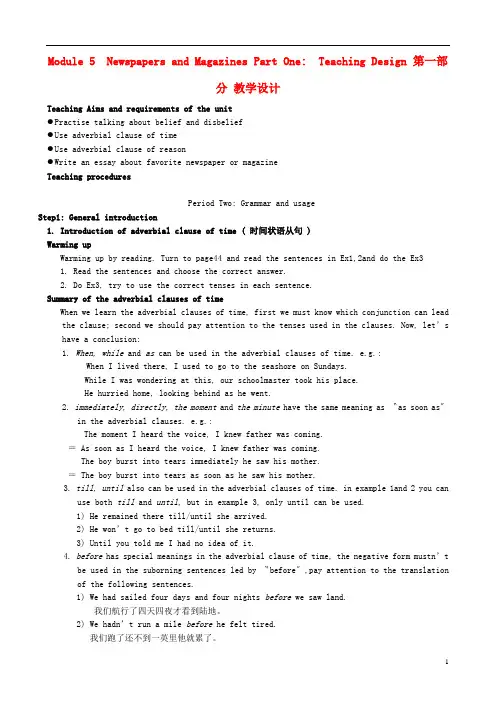
Module 5 Newspapers and Magazines Part One: Teaching Design 第一部分教学设计Teaching Aims and requirements of the unit●Practise talking about belief and disbelief●Use adverbial clause of time●Use adverbial clause of reason●Write an essay about favorite newspaper or magazineTeaching proceduresPeriod Two: Grammar and usageStep1: General introduction1. Introduction of adverbial clause of time ( 时间状语从句 )Warming upWarming up by reading. Turn to page44 and read the sentences in Ex1,2and do the Ex31. Read the sentences and choose the correct answer.2. Do Ex3, try to use the correct tenses in each sentence.Summary of the adverbial clauses of timeWhen we learn the adverbial clauses of time, first we must know which conjunction can lead the clause; second we should pay attention to the tenses used in the clauses. Now, let’s have a conclusion:1. When, while and as can be used in the adverbial clauses of time. e.g.:When I lived there, I used to go to the seashore on Sundays.While I was wondering at this, our schoolmaster took his place.He hurried home, looking behind as he went.2. immediately, directly, the moment and the minute have the same meaning as 〝as soon as〞in the adverbial clauses. e.g.:The moment I heard the voice, I knew father was coming.= As soon as I heard the voice, I knew father was coming.The boy burst into tears immediately he saw his mother.= The boy burst into tears as soon as he saw his mother.3. till, until also can be used in the adverbial clauses of time. in example 1and 2 you canuse both till and until, but in example 3, only until can be used.1) He remained there till/until she arrived.2) He wo n’t go to bed till/until she returns.3) Until you told me I had no idea of it.4. before has special meanings in the adverbial clause of time, the negative form mustn’tbe used in the suborning sentences led by 〝before〞,pay attention to the translation of the following sentences.1) We had sailed four days and four nights before we saw land.我们航行了四天四夜才看到陆地。
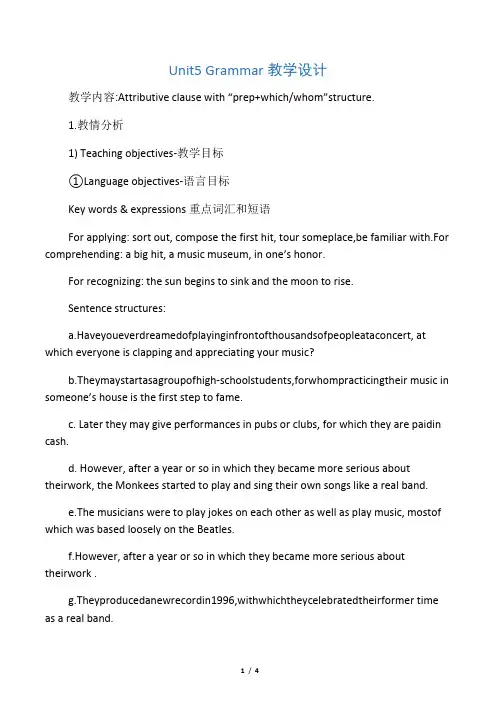
Unit5 Grammar教学设计教学内容:Attributive clause with “prep+which/whom”structure.1.教情分析1) Teaching objectives-教学目标①Language objectives-语言目标Key words & expressions重点词汇和短语For applying: sort out, compose the first hit, tour someplace,be familiar with.For comprehending: a big hit, a music museum, in one’s honor.For recognizing: the sun begins to sink and the moon to rise.Sentence structures:a.Haveyoueverdreamedofplayinginfrontofthousandsofpeopleataconcert, at which everyone is clapping and appreciating your music?b.Theymaystartasagroupofhigh-schoolstudents,forwhompracticingtheir music in someone’s house is the first step to fame.c. Later they may give performances in pubs or clubs, for which they are paidin cash.d. However, after a year or so in which they became more serious about theirwork, the Monkees started to play and sing their own songs like a real band.e.The musicians were to play jokes on each other as well as play music, mostof which was based loosely on the Beatles.f.However, after a year or so in which they became more serious about theirwork .g.Theyproducedanewrecordin1996,withwhichtheycelebratedtheirformer time as a real band.h. I remember the day when our band was formed as if it was yesterday.i. The guitar with which Dave composed our first hit is in a music museum.j. The name by which we were to become famous was chosen by Mike’s mum.②Ability goals能力目标EnabletheSstousetheattributiveclausewiththeprepositionaheadoftherelative clause correctly.③Emotion goals情感目标Enable the Ss to keep interest in studying attributive clause.2) Important & difficult teaching points-教学重难点①Important teaching points-教学重点GettheSstousetheAttributiveClausewiththeprepositionaheadoftherelative clause.②Difficult teaching points-教学难点Howtoteachthestudentstheusageoftheattributiveclausewiththepreposition ahead of the relative clause.2.Students analysis学情分析1) Fundamental state基本情况这是一节关于定语从句的语法课,定语从句的概念以及常见的用法从初中就开始接触,从Book I开始较为深入的学习和研究,同学们对此并不陌生;但是,prep.+which/whom结构的定语从句,对于介词的选用一直是难点,需要给学生大量的例句和语法情景,让学生能够理解,并且运用。
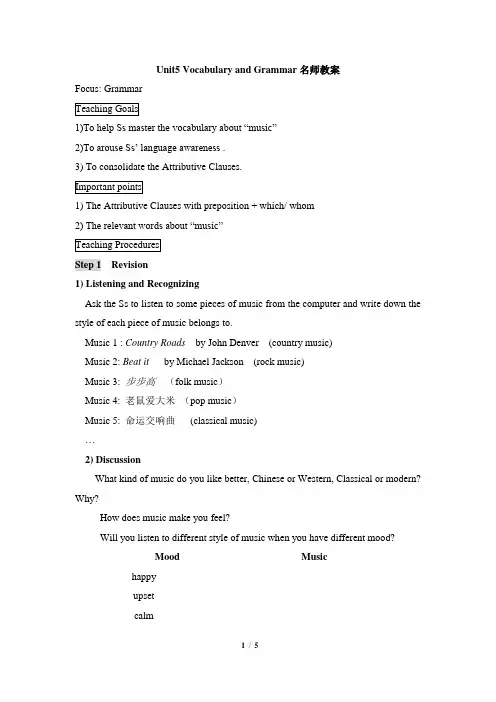
Unit5 Vocabulary and Grammar名师教案Focus: Grammar1)To help Ss master the vocabulary about “music”2)To arouse Ss’ language awareness .3) To consolidate the Attributive Clauses.1) The Attributive Clauses with preposition + which/ whom2) The relevant words about “music”Step 1 Revision1) Listening and RecognizingAsk the Ss to listen to some pieces of music from the computer and write down the style of each piece of music belongs to.Music 1 : Country Roads by John Denver (country music)Music 2: Beat it by Michael Jackson (rock music)Music 3: 步步高(folk music)Music 4: 老鼠爱大米(pop music)Music 5: 命运交响曲(classical music)…2) DiscussionWhat kind of music do you like better, Chinese or Western, Classical or modern? Why?How does music make you feel?Will you listen to different style of music when you have different mood?Mood Musichappyupsetcalmangrynervous…3) Check the homework the day before.Step 2 Word Power1) Word LadderComplete these sentences. Then write the missing words in the puzzle on the right and find the hidden word. (WB P 70)2) Word BuildingStudy the vocabulary list in the appendix and list the words with un-,dis-, -less, -ful, -ment, -ity, -en, -ern, -al , -tion. Tell what part of speech they are. This will you help English words.3) Recognizing and ListingTick (√)the words which are connected with “music”and find out the meanings of those unfamiliar ones.rap composer piano Mozart performance band rock audience musician singer classical jazz violinAdd your own to the list _________________________________________________4)Discussion and ListingWhich instruments are used in pop and rock music?Which instruments are used in classical music?Which instruments are used in jazz?Which instruments are used in traditional Chinese music?Which of the instruments do you like listening to?Is the Chinese instrument different from the other instruments? Describe the difference, if there is one.Information Box: musical instrumentsPiano, violin, organ, harp, maracas, saxophone, gone, cymbals,castanets, flute, timpani, tambourine, triangle, drum, xylophone,guitar ,Step 3 Grammar1) Study the RuleRead these sentences.a. The musicians of whom the band was formed played jokes on each other…b. However, after a year or so in which they became more serious about their work…c. The musicians for whom they worked were very popular.d. The guitar with which“The Beatles” played their first hit was lost while they were touring.Now answer these questions.1. If you take away the relative clauses, do the sentences still make sense? Why or why not ?2.Why is there a relative pronoun before the relative clause?3. Can the preposition be removed from the sentences without changing the meaning?4. Can that replace which and whom in the sentences? Why or why not?Look at the sentences carefully and try to think of the questions.2) Find the ruleGet the Ss to think of the questions above and sum up the grammar rule of preposition + the relative clause.Tips:the + 名词+of +关系代词whom, which 结构中的名词与后面的关系代词的所属关系部分结构+of +关系代词whom, which All, both ,none, etc.; 数词+名词;the +形容词最高级/比较级3) Apply the ruleGet the Ss to describe each picture with The Attributive Clause according to the following example:Goal: To recall the Attributive Clause they learned before, and practice orally. Learn to use relative pronouns referring to people and things correctly. To stimulate Ss creative thinking. Working together with partners can develop cooperative sense.1. Take me Home Country Roads is a beautiful song.In the song, John Denver acts as a singer.Take me Home Country Roads is a beautiful songin which John Denver acts as a singer.2. 步步高is a piece of famous Guangdong music.Flute is one of the main instruments in it.步步高is a piece of famous Guangdong musicin which flute is one of the main instruments.3. Talk about the musician Nie’er (聂耳).Nieer was born in 1912.Nieer was born in Kunming.Nieer died in 1935.Nieer died in Japan.Nieer was the composer of our national song.1912 is the year ______ / ______ _______ Nieer was born.Kunming is the place _______ / _____ _______ Nieer was born..1935 is the year ______ / ______ _______ Nieer died.Japan is the place _______ / _____ _______ Nieer died.Step 4 Homework1. Review the vocabulary in this unit and prepare for diction.2. Find as many kinds of musical instruments as possible. (surf the internet)3. Find one song for each music style。
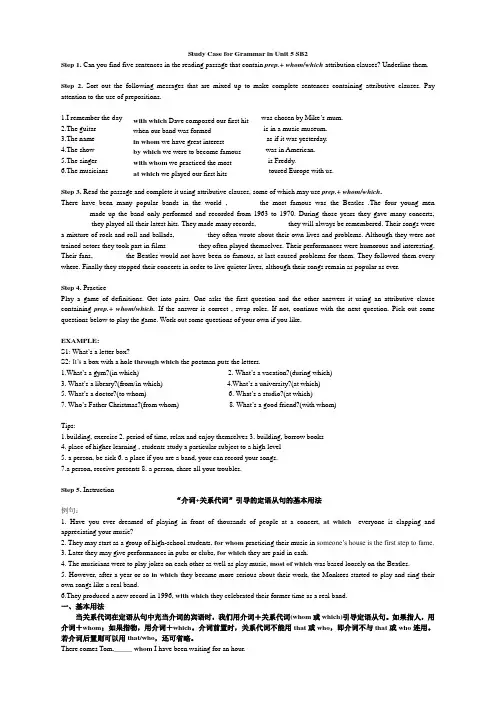
Study Case for Grammar in Unit 5 SB2Step 1. Can you find five sentences in the reading passage that contain prep.+ whom/which attribution clauses? Underline them.Step 2. Sort out the following messages that are mixed up to make complete sentences containing attributive clauses. Pay attention to the use of prepositions.1.I remember the day was chosen by Mike ’s mum.2.The guitar is in a music museum.3.The name as if it was yesterday.4.The show was in American.5.The singer is Freddy.6.The musicians toured Europe with us.Step 3. Read the passage and complete it using attributive clauses, some of which may use prep.+ whom/which .There have been many popular bands in the world ,________ the most famous was the Beatles .The four young men ________made up the band only performed and recorded from 1963 to 1970. During those years they gave many concerts, ________ they played all their latest hits. They made many records, ________ they will always be remembered. Their songs were a mixture of rock and roll and ballads, ________ they often wrote about their own lives and problems. Although they were not trained actors they took part in films ________ they often played themselves. Their performances were humorous and interesting. Their fans, ________ the Beatles would not have been so famous, at last caused problems for them. They followed them every where. Finally they stopped their concerts in order to live quieter lives, although their songs remain as popular as ever.Step 4. PracticePlay a game of definitions. Get into pairs. One asks the first question and the other answers it using an attributive clause containing prep.+ whom/which. If the answer is correct , swap roles. If not, continue with the next question. Pick out some questions below to play the game. Work out some questions of your own if you like.EXAMPLE:S1: What ’s a letter box?S2: It’s a box with a hole through which the postman puts the letters.1.What ’s a gym?(in which)2. What ’s a vacation?(during which)3. What ’s a library?(from/in which)4.What ’s a university?(at which)5. What ’s a doctor?(to whom)6. What ’s a studio?(at which)7. Who ’s Father Christmas?(from whom) 8. What ’s a good friend?(with whom)Tips:1.building, exercise2. period of time, relax and enjoy themselves3. building, borrow books4. place of higher learning , students study a particular subject to a high level5. a person, be sick6. a place if you are a band, your can record your songs.7.a person, receive presents 8. a person, share all your troubles.Step 5. Instruction“介词+关系代词”引导的定语从句的基本用法例句:1. Have you ever dreamed of playing in front of thousands of people at a concert, at which everyone is clapping and appreciating your music?2. They may start as a group of high-school students, for whom practicing their music in someone’s house is the first step to fame.3. Later they may give performances in pubs or clubs, for which they are paid in cash.4. The musicians were to play jokes on each other as well as play music, most of which was based loosely on the Beatles.5. However, after a year or so in which they became more serious about their work, the Monkees started to play and sing their own songs like a real band.6.They produced a new record in 1996, with which they celebrated their former time as a real band.一、基本用法当关系代词在定语从句中充当介词的宾语时,我们用介词+关系代词(whom 或which)引导定语从句。
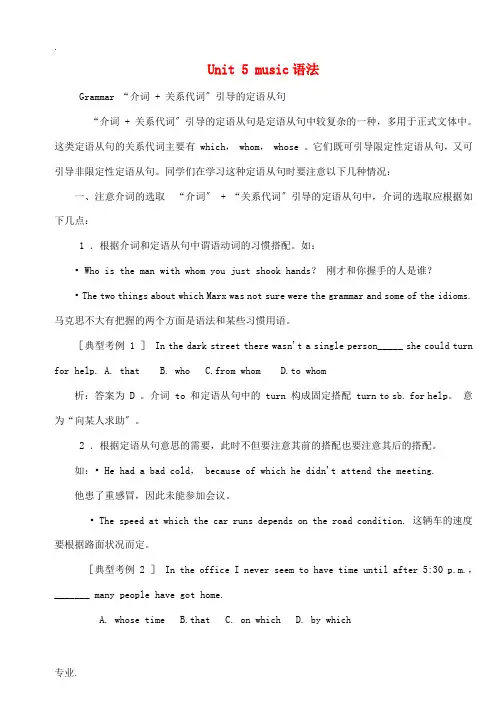
Unit 5 music语法Grammar “介词 + 关系代词〞引导的定语从句“介词 + 关系代词〞引导的定语从句是定语从句中较复杂的一种,多用于正式文体中。
这类定语从句的关系代词主要有 which, whom, whose 。
它们既可引导限定性定语从句,又可引导非限定性定语从句。
同学们在学习这种定语从句时要注意以下几种情况:一、注意介词的选取“介词〞+ “关系代词〞引导的定语从句中,介词的选取应根据如下几点:1 .根据介词和定语从句中谓语动词的习惯搭配。
如:• Who is the man with whom you just shook hands?刚才和你握手的人是谁?• The two things about which Marx was not sure were the grammar and some of the idioms. 马克思不大有把握的两个方面是语法和某些习惯用语。
[典型考例 1 ] In the dark street there wasn't a single person_____ she could turn for help. A. that B. who C.from whom D.to whom析:答案为 D 。
介词 to 和定语从句中的 turn 构成固定搭配 turn to sb. for help。
意为“向某人求助〞。
2 .根据定语从句意思的需要,此时不但要注意其前的搭配也要注意其后的搭配。
如:• He had a bad cold, because of which he didn't attend the meeting.他患了重感冒,因此未能参加会议。
• The sp eed at which the car runs depends on the road condition. 这辆车的速度要根据路面状况而定。
[典型考例 2 ] In the office I never seem to have time until after 5:30 p.m.,_______ many people have got home.A. whose timeB.thatC. on whichD. by which析:答案为 D 。
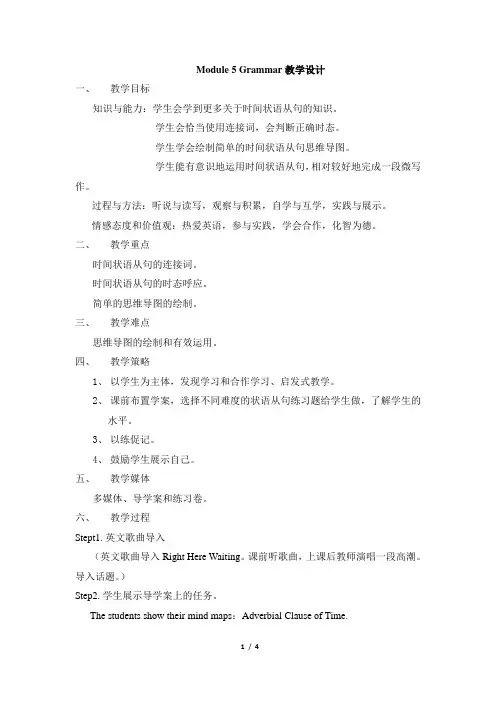
Module 5 Grammar教学设计一、教学目标知识与能力:学生会学到更多关于时间状语从句的知识。
学生会恰当使用连接词,会判断正确时态。
学生学会绘制简单的时间状语从句思维导图。
学生能有意识地运用时间状语从句,相对较好地完成一段微写作。
过程与方法:听说与读写,观察与积累,自学与互学,实践与展示。
情感态度和价值观:热爱英语,参与实践,学会合作,化智为德。
二、教学重点时间状语从句的连接词。
时间状语从句的时态呼应。
简单的思维导图的绘制。
三、教学难点思维导图的绘制和有效运用。
四、教学策略1、以学生为主体,发现学习和合作学习、启发式教学。
2、课前布置学案,选择不同难度的状语从句练习题给学生做,了解学生的水平。
3、以练促记。
4、鼓励学生展示自己。
五、教学媒体多媒体、导学案和练习卷。
六、教学过程Stept1.英文歌曲导入(英文歌曲导入Right Here Waiting。
课前听歌曲,上课后教师演唱一段高潮。
导入话题。
)Step2.学生展示导学案上的任务。
The students show their mind maps:Adverbial Clause of Time.Stept3.结合导学案,引导学生思考、讨论、总结、练习。
1. when, while, as1) When/While you are crossing the street, you have to be careful.2) The boy was crying when I arrived there.3) Don’t read a book as you are watching TV.4) As time went on, his teachings proved correct.2. till/until1) The fans waited for her patiently till/until Yang Mi appeared.2) We didn’t go to bed until we finished our homework.3. before1) It will be five years before he returns from abroad.2) It was not long before he returned from abroad.3) Tom rushed out before I could stop him.4) I’ll write it down before I forget it.5) Be a student before you become a teacher.4. Since1) He has finished two novels since he began writing.2) It is/has been three years since he left his hometown.3) It is/has been three years since he was a soldier.5.表示“一……就……”1) Please let me know as soon as he arrives.2) The moment/second/minute I saw the thief, he ran away.3) It began to rain immediately/directly/instantly we arrived home.4) She had no sooner heard of her husband’s death than she cried.5) She had hardly heard of her husband’s death when she cried.6.其他引导时间状语从句的短语。
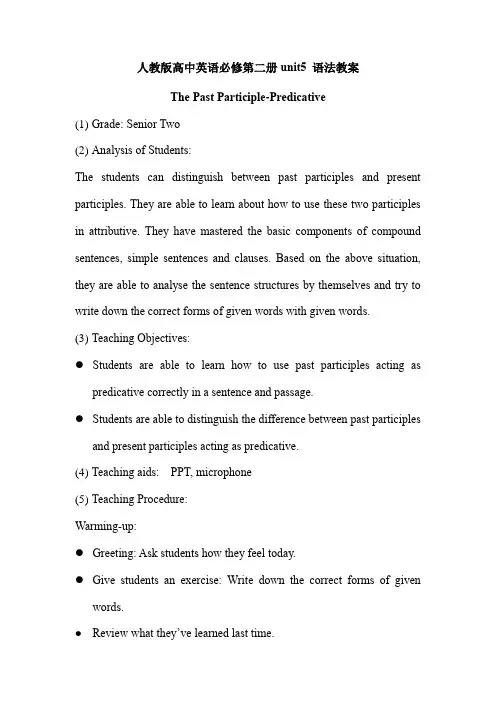
人教版高中英语必修第二册unit5 语法教案The Past Participle-Predicative(1)Grade: Senior Two(2)Analysis of Students:The students can distinguish between past participles and present participles. They are able to learn about how to use these two participles in attributive. They have mastered the basic components of compound sentences, simple sentences and clauses. Based on the above situation, they are able to analyse the sentence structures by themselves and try to write down the correct forms of given words with given words.(3)Teaching Objectives:●Students are able to learn how to use past participles acting aspredicative correctly in a sentence and passage.●Students are able to distinguish the difference between past participlesand present participles acting as predicative.(4)Teaching aids: PPT, microphone(5)Teaching Procedure:Warming-up:●Greeting: Ask students how they feel today.●Give students an exercise: Write down the correct forms of givenwords.●Review what they’ve learned last time.Presentation:●Discuss how to define predicative.●Learn usage of past participles acting as predicative.●Learn the difference between past participles and present participlesacting as predicative.●Learn some common words about past participles and presentparticiples acting as predicative.●Learn the difference between past participles acting as predicative andpassive voice.Practice:●Choose the correct answer, learning how to use past participles actingas predicative correctly.Production:●Choose one or two topics below and write a paragraph about yourfeelings or experience using some words in their-ed or -ing forms. Summary:●I summarize what we have learned today.。
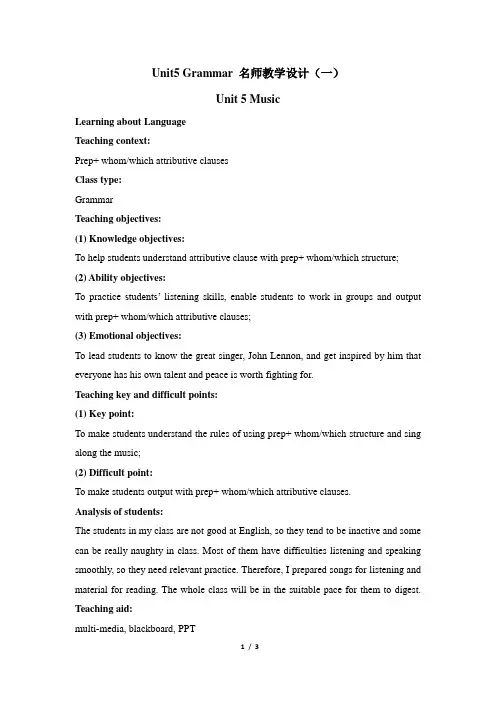
Unit5 Grammar 名师教学设计(一)Unit 5 MusicLearning about LanguageTeaching context:Prep+ whom/which attributive clausesClass type:GrammarTeaching objectives:(1) Knowledge objectives:To help students understand attributive clause with prep+ whom/which structure; (2) Ability objectives:To practice students’listening skills, enable students to work in groups and output with prep+ whom/which attributive clauses;(3) Emotional objectives:To lead students to know the great singer, John Lennon, and get inspired by him that everyone has his own talent and peace is worth fighting for.Teaching key and difficult points:(1) Key point:To make students understand the rules of using prep+ whom/which structure and sing along the music;(2) Difficult point:To make students output with prep+ whom/which attributive clauses.Analysis of students:The students in my class are not good at English, so they tend to be inactive and some can be really naughty in class. Most of them have difficulties listening and speaking smoothly, so they need relevant practice. Therefore, I prepared songs for listening and material for reading. The whole class will be in the suitable pace for them to digest. Teaching aid:multi-media, blackboard, PPTTeaching procedures:Step 1: Lead-in1) Greet the class.2) Introduce the Beatles by singing Hey, Jude and playing a music video. From this video, students can get to know how crazy their fans were.3) After the video, the topic grammar is introduced by replacing:They were so popular that when their fans met idols, they were just like you class in sports meeting, where everyone of you took an active part. (Show them pictures for contrast.)T: Here, the underlined word “where” can be replaced by “in which”, and tha t’s what we are to learn today-- attributive clauses with preposition and which/whom.4) Lead students to the main character of this class-- John Lennon, the leader of the Beatles.Step 2: Get close to John Lennon through his photo album1) Introduce the three periods of John’s life:T: When we open John’s photo album, we can find there are three periods of John’s life: Youth of A Troublemaker, Road to A Musical Master, Fighter for Peace and Rights.2) Listening Practice: Lead in to Youth of A Troublemaker with a photo, and appreciate a happy song written by little John and complete the lyrics.Through the lines with attributive clause, students will recall some knowledge about attributive clause.3) Conclude from the lyrics and get a form:4) Period 1-- Youth of a TroublemakerGive a short summary of John’s youth with some pictures, and show John’s autobiography to make students replace where, when, why in the passage with prep+ which/whom.Step 3: Period 2--Road to A Musical Master1)Listening Practice: Listen to the songs recommended by John and fill in the blanks in lyrics with prep+ which.2) Group work: Show students a piece of report about John in album, some of whose words are missing. Students need to discuss in groups to find the correct words from three answer cards and then stand up holding their answers.When asked for answer, a student of each group stands up showing their answer cards-- whom, by, which.Step 4: Period 3-- A Fighter for Peace and Rights1) Review the three periods of John Lennon, through which he matured from a boy toa man, and finally he became a warrior. Introduce period 3 with Yoko’s letter.2) Read together and appreciate the prep+ which structures in the letter, and make students discuss to combine the underlined simple sentences into prep+ which/whom attributive clause.3) Explore John’s dream for which he died through a music video and sing along it. Step 5: Group work-- Present John with our own awards.Brainstorm to award Lennon with a title and design the prize for him. students have to give comments with prep+ which/whom on the prize. Through this activity, students will get a deeper impression and better understanding of this music talent, meanwhile they will output what they have learned today.Step 6: Reflection1. I was always introducing John Lennon, so I spoke too much but students didn’t.2. Students can be more active, so I should really arouse their interest and attention, and give instructions more clearly.3. My gesture and body language were not confident or graceful enough.4. At the end of the class, I should lead students to recall what we’ve learned today, and set homework.。
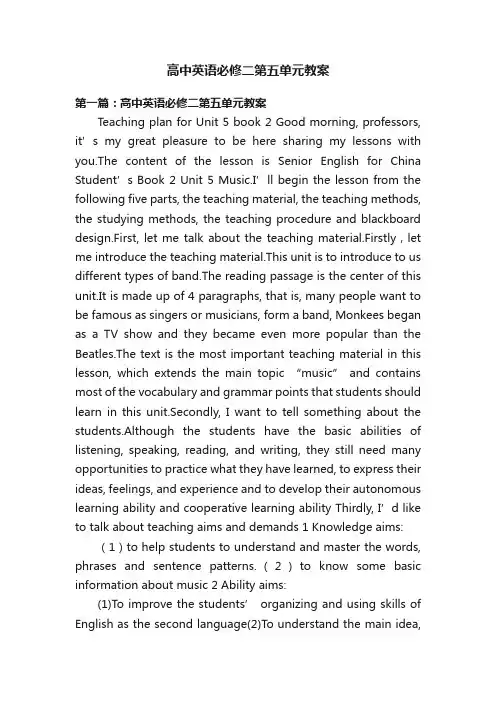
高中英语必修二第五单元教案第一篇:高中英语必修二第五单元教案Teaching plan for Unit 5 book 2 Good morning, professors, it’s my great pleasure to be here sharing my lessons with you.The content of the lesson is Senior English for China Student’s Book 2 Unit 5 Music.I’ll begin the lesson from the following five parts, the teaching material, the teaching methods, the studying methods, the teaching procedure and blackboard design.First, let me talk about the teaching material.Firstly,let me introduce the teaching material.This unit is to introduce to us different types of band.The reading passage is the center of this unit.It is made up of 4 paragraphs, that is, many people want to be famous as singers or musicians, form a band, Monkees began as a TV show and they became even more popular than the Beatles.The text is the most important teaching material in this lesson, which extends the main topic “music” and contains most of the vocabulary and grammar points that students should learn in this unit.Secondly, I want to tell something about the students.Although the students have the basic abilities of listening, speaking, reading, and writing, they still need many opportunities to practice what they have learned, to express their ideas, feelings, and experience and to develop their autonomous learning ability and cooperative learning ability Thirdly, I’d like to talk about teaching aims and demands 1 Knowledge aims: (1)to help students to understand and master the words, phrases and sentence patterns.(2)to know some basic information about music 2 Ability aims:(1)To improve the students’ organizing and using skills of English as the second language(2)To understand the main idea,to scan for the needed information and to grasp the details 3 Emotional aims:(1)Help students understand different type of music and how to form a band(2)Develop students’ sense of cooperative learning Fourthly, teaching key points is 1.To help the students get a general idea of the whole passage, and some detailed information and language points as well.2.To understand how Monkees formed, developed and succeed.Teaching difficult points is 1.The students use their own words to express their own ideas.2.the prep+ whom/which attribute clause According to the analysis above, I’ll try to use the following theories to make students the real master of the class while the teacher myself the municative Language TeachingLanguage is used for communication.It’s learner-centered and emphasizes communication and real-life situations.b.Task-based Language T eachingA task resembles activities which our students or other people carry out in everyday life, Learners should be given opportunities to reflect on what they have learned and how well they are puter Assisted Language T eaching Language learning needs a context, which can help the learners to understand the language and then can product comprehensible output, so computer has the advantages to make the materials attractive.Part 3 Learning Methods Task-based, self-dependent and cooperative learning Part 4 Teaching Procedure Step One Lead-in “Interest is the best teacher.” Therefore, at the very beginning of the class, I should spark the students’ mind to focus on the centre topic “the band”.I’ll play some different type of music to attract their attention and then bring some questions.Question: What kind of music theylike? Which band they know best? The answers must relate to band.After this, the students will be eager to know something about band and this is the very time to naturally lead the class into Step 2 Step 2 Reading for information: skimming and scanning In this step, I use Task-based Language Teaching method, which can give students a clear and specific purpose while skimming and scanning the context.Task 1 General idea The students will be asked to just glance at the title and the pictures of the passage, and then guess what they will read in the text.And they’ll be divided into groups of four to have a discussion.The purpose is to inspire the students to read actively, not passively.In addition, the task is to develop the students’ reading skill by making prediction and to encourage the students to express their thoughts in English and cooperate with each other.Task 2 Main idea of each paragraphCooperative learning can raise the students’ interest and create an atmosphere of achievement.Based on this theory, I divide the whole class into 4 groups to skim the whole text and get the main idea of each paragraph.Step 3 Reading for comprehension The purpose of reading is to get the correct and useful information.Students should not only have a high speed of reading but also have a correct understanding of details.Therefore the following practices on Page 35 can help check the situation.Step 4 Solving difficult language problems through readingIt’s important for language learners to learn important rules of grammar and use these rules to solve problems in reality.In the previous process of reading, the students must come across some difficult language obstacles, so it’s necessary for us to discuss and explain.This period of time belongs to students.Theycan ask any questions they come across in the process of learning.I’ll explain the questions and difficulties.The purpose of this is improving the students “questioning spirit” and dealing with the difficulties.Step 5 Consolidation Language is learnt by communicating.It is my job to create an atmosphere for students to use the language.Here I design 2 activities 1 Reading for comprehens ion I’ll ask 4 students to read each paragraph, and then do the exercise following the text.I think it’s a good way to review what they have learned.2 DiscussionDuring making discussion, the students will deepen their understanding of the main idea of the passage.a.Why Monkees can be successful? Give reasons.b.What’s the most important thing for a successful band? Why? Step 6 Homework Ask the students to write down sth about their favorite singers, band or music and list the reasons.The assignment enables the students to search various information resources, which can widen their view and continue to inspire their enthusiasm of learning.Part 5 Blackboard design Unit 4 Music Passage The Band That Wasn’t Topic Sentences: 1.Many people want to be famous as singers or musician 2.Form a band 3.Began as a TV 4.They became even more famous than the Beatles Discussion: a.Why Monkees can be successful? Give reasons.b.What’s the most important thing for a successful band? Why? In my opinion, the blackboard design can reflect the teacher’s ability of mastering the text and leading the students to master the text easily.In this text, the design is not easy to write.I write the topic sentences on the blackboard, in order to tell the students that this is of the importance in this class.I want to make the design inductive, instructive and artistic.第二篇:高中英语必修二第一单元教案珍藏版必修二 Unit 1教案一、复习旧知(1)表建议的句子:How/what about doing sth.? Why not do sth.? Why don’t you do sth.? Would you like sth./to do sth.? Shall we do sth.?(2)询问别人意见What do you think of sth./doing sth.? How do you like sth.? What is your idea/opinion of sth./doing sth.? How do you know that? Don’t/do you think that …?(3)表达自己的意见I think/believe/suppose that..In my opinion/view…依我之见Sorry, I don’t agree with you.No,tha nks./Yes, please 备注:此部分内容常见于听力单选情景会话中,理解了说话人的场合,语气,便于迅速答题。
高一英语外研必修2模块5grammar教案一、教学目标1.知识目标:(1)掌握情态动词can,may,must的用法及区别。
(2)学会使用情态动词描述能力、可能性、必要性等情境。
(3)能够运用情态动词完成相关练习。
2.能力目标:(1)提高学生运用情态动词进行口语表达的能力。
(2)培养学生通过观察、分析、归纳总法规则的能力。
3.情感目标:激发学生对英语学习的兴趣,培养合作精神和团队意识。
二、教学重难点1.教学重点:(1)情态动词can,may,must的用法及区别。
(2)情态动词在句子中的运用。
2.教学难点:(1)情态动词can,may,must在不同语境中的具体用法。
(2)如何准确把握情态动词在句子中的意义和功能。
三、教学过程1.导入利用多媒体播放一段关于能力、可能性、必要性的视频,引导学生关注情态动词的用法。
2.新课导入(1)引导学生回顾已学的情态动词can,may,must的基本用法。
(2)展示一些例句,让学生猜测句子中情态动词的意义。
3.课堂讲解(1)讲解情态动词can,may,must的用法及区别。
(2)通过例句分析情态动词在句子中的意义和功能。
4.课堂练习(1)让学生完成一些填空、改写句子的练习,巩固情态动词的用法。
(2)分组讨论,让学生运用情态动词描述自己的能力、可能性、必要性等。
5.小组活动(1)让学生分成小组,用情态动词编写一段对话或故事。
(2)每组选代表进行展示,其他组进行评价。
(2)布置课后作业,要求学生运用情态动词进行写作。
四、课后作业1.完成课后练习册中关于情态动词的练习。
2.运用情态动词编写一篇小作文,描述自己的能力、可能性、必要性等。
五、教学反思本节课通过生动的例子和丰富的练习,让学生掌握了情态动词can,may,must的用法。
在课堂活动中,学生积极参与,提高了运用情态动词进行口语表达的能力。
但在教学过程中,仍有个别学生对于情态动词的用法掌握不够熟练,需要在课后加强巩固。
高一英语必修二第五单元语法教案Period 2: A sample lesson plan for Learning about Language(The Attributive Clause (in/ for/ with/ by+which/ whom).AimsTo help students learn about the Attributive Clause with a preposition in front.TTo help students discover and learn to use some useful structures.ProceduresI. Learning about grammar1.Reading and thinkingTurn to page 34 and read with me the text of THE BAND THAT W ASN’t. As you read on, pay attention to The Attributive Clause (in/ for/ with/ by+which/ whom), that is, theII. Turn to page 34. Look at the two sentences:The musicians of whom the band was formed played jokes on each other as well as played music.However, after a year or so in which they became more serious about their work, “The Monkees”started to play their own instruments and write their own songs like a real band.Pay attention to the structure: preposition + relative pronoun. Usually only two relative pronouns--- which and whom--- can be used in the Attributive Clause, with a preposition put before theclause. That can’t be used. Look at the screen. Here are more examples on this kind of structure.Now go on to do Exercise No. 2 on page 36, that is, to sort out the sentences.III. Ready used materials for The Attributive Clause (in/ for/ with/ by+which/ whom)In formal styles we often put a preposition before the relative pronouns which and whom:•The rate at which a material heats up depends on its chemical composition.•In the novel by Peters, on which the film is based, the main character is a teenager.•An actor with whom Gelson had previously worked contacted him about the role.•Her many friends, among whom I like to be considered, gave her encouragement.Notice that after a preposition you can’t use who in place of whom, and you can’t use that or zero relative pronoun either:•Is it right that politicians should make important decisions without consulting the public to whom they are accountable (not --- the public to who they are accountable.)•The valley in which the town lies is heavily polluted. (not --- The valley in that the town...) •Arnold tried to gauge the speed at which they were traveling. (not --- the speed at they were traveling.)In informal English we usually put the preposition at the end in attributive clauses rather than at the beginning:•The office which Graham led the way to was filled with books.•Jim’s footballing ability, which he was noted for, had been encouraged by his parents.•The playground wasn’t used by those children who it was built for.In this case we prefer who rather than whom(although whom is used in formal contexts). In restrictive attributive clauses we can also use that or zero relative pronoun instead of who or which . ...the children (that) it was built for).If the verb in attributive clauses is a two-or-three-word verb . come across, fill in, go through, look after, look up to, put up with, take on) we don’t usually put the preposition at the beginning:•Your essay is one of those (which/that) I’ll go through tomorrow. (rather than...through which I’ll go tomorrow.)•She is one of the few people (who/that) I look up to. (not ... to whom I look up.)In formal written English, we often prefer to use of which rather than whose to talk about things: •A huge amount of oil was spilled, the effects of which are still being felt. (or...whose effects are still being felt.)•The end of the war, the anniversary of which is on the 16th of November, will be commemoratedin cities throughout the country. (or...whose anniversary is on...)Note that we can’t use of which in place of whose in the patterns described in Unit 71B: •Dorothy was able to switch between German, Polish and Russian, all of which she spoke fluently. (not..,all whose she spoke...)We can sometimes use that...of in place of of which. This is less formal than of which and whose, and is mainly used in spoken English:•The school that she is head of is closing down. (or The school of which she is head...)Whose can come after a preposition in attributive clauses. However, it is more natural to put the preposition at the end in less formal contexts and in spoken English:•We were grateful to Mr. Marks, in whose car we had traveled home. (or...whose car we had traveled home in.)•I now turn to Freud, from whose work the following quotation is taken. (or...whose work the following quotation is taken from.)IV. Closing down by doing exercises:Join the sentence halves using which or whom after an appropriate preposition. (A)a.I would never have finished the work.b.It was primarily written.c.We know nothing.d.They got a good view.e.He learned how to play chess.f.Dennis scored three goals in the final.g.She was born.h.It was discovered.climbed up to the top of a large rock.2. I would like to thank my tutor.3. She has now moved back to the house on Long Island.4. The star is to be named after Patrick Jenks.S. This is the ball.6. He is now able to beat his father.7. The book is enjoyed by adults as well as children.8. There are still many things in our solar system.Are these correct or appropriate If they are, put a√. If they are not, give a reason, correct them and give alternatives if you can. (A)I. It's a piece of jewelry across which I came in an antique shop. --- which I came across in an antique shop. (‘came across’ is a two-word verb.)2. The extra work which she took on was starting to affect her health.3. My mother, after whom I looked for over 20 years, died last year.4. The people whom I work with are all very friendly.5. Some of the criticisms with which they had to put up were very unfair.6. He had many friends with whom he had a regular correspondence.7. The woman to who he is engaged comes from Poland.8. The forms which I had to fill in were very complicated.Rewrite these sentences so that they are more appropriate for formal written English. Use preposition + which or preposition + whose, as appropriate. (B)I. Tom Sims, whose car the weapons were found in, has been arrested. Torn Sims, in whose car the weapons were found, has been arrested.2. Tom Ham, whose novel the TV series is based on, will appear in the first episode.3. Dr Jackson owns the castle whose grounds the main road passes through.4. Tessa Parsons is now managing director of Simons, the company that she was once a secretary in.5. Allowing the weapons to be sold is an action that the Government should be ashamed of.6. The dragonfly is an insect that we know very little of。
高一英语必修二第五单元语法教案Period 2: A sample lesson plan for Learning about Language(The Attributive Clause (in/ for/ with/ by+which/ whom).AimsTo help students learn about the Attributive Clause with a preposition in front.TTo help students discover and learn to use some useful structures.ProceduresI. Learning about grammar1.Reading and thinkingTurn to page 34 and read with me the text of THE BAND THAT WASN’t. As you read on, pay attention to The Attributive Clause (in/ for/ with/ by+which/ whom), that is, the attributiveII. Turn to page 34. Look at the two sentences:The musicians of whom the band was formed played jokes on each other as well as played music.However, after a year or so in which they became more serious about their work, “The Monkees”started to play their own instruments and write their own songs like a real band.Pay attention to the structure: preposition + relative pronoun. Usually only two relative pronouns--- which and whom--- can be used in the Attributive Clause, with a preposition put before theclause. That can’t be used. Look at the screen. Here are more examples on this kind of structure.Now go on to do Exercise No. 2 on page 36, that is, to sort out the sentences.III. Ready used materials for The Attributive Clause (in/ for/ with/ by+which/ whom)In formal styles we often put a preposition before the relative pronouns which and whom:The rate at which a material heats up depends on its chemical composition.In the novel by Peters, on which the film is based, the main character is a teenager.An actor with whom Gelson had previously worked contacted him about the role.Her many friends, among whom I like to be considered, gave her encouragement.Notice that after a preposition you can’t use who in place of whom, and you can’t use that or zero relative pronoun either:Is it right that politicians should make important decisions without consulting the public to whom they are accountable (not --- the public to who they are accountable.)The valley in which the town lies is heavily polluted. (not --- The valley in that the town...) Arnold tried to gauge the speed at which they were traveling. (not --- the speed at they were traveling.)In informal English we usually put the preposition at the end in attributive clauses rather than at the beginning:The office which Graham led the way to was filled with books.Jim’s footballing ability, which he was noted for, had been encouraged by his parents.The playground wasn’t used by those children who it was built for.In this case we prefer who rather than whom (although whom is used in formal contexts). In restrictive attributive clauses we can also use that or zero relative pronoun instead of who or which . ...the children (that) it was built for).If the verb in attributive clauses is a two-or-three-word verb . come across, fill in, go through, look after, look up to, put up with, take on) we don’t usually put the preposition at the beginning:Your essay is one of those (which/that) I’ll go through tomorrow. (rather than...through w hich I’ll go tomorrow.)She is one of the few people (who/that) I look up to. (not ... to whom I look up.)In formal written English, we often prefer to use of which rather than whose to talk about things:A huge amount of oil was spilled, the effects of which are still being felt. (or...whose effects arestill being felt.)The end of the war, the anniversary of which is on the 16th of November, will be commemorated in cities throughout the country. (or...whose anniversary is on...)Note that we can’t use of which in place of whose in the patterns described in Unit 71B: Dorothy was able to switch between German, Polish and Russian, all of which she spoke fluently. (not..,all whose she spoke...)We can sometimes use that...of in place of of which. This is less formal than of which and whose, and is mainly used in spoken English:The school that she is head of is closing down. (or The school of which she is head...)Whose can come after a preposition in attributive clauses. However, it is more natural to put the preposition at the end in less formal contexts and in spoken English:We were grateful to Mr. Marks, in whose car we had traveled home. (or...whose car we had traveled home in.)I now turn to Freud, from whose work the following quotation is taken. (or...whose work the following quotation is taken from.)IV. Closing down by doing exercises:Join the sentence halves using which or whom after an appropriate preposition. (A)a.I would never have finished the work.b.It was primarily written.c.We know nothing.d.They got a good view.e.He learned how to play chess.f.Dennis scored three goals in the final.g.She was born.h.It was discovered.climbed up to the top of a large rock.2. I would like to thank my tutor.3. She has now moved back to the house on Long Island.4. The star is to be named after Patrick Jenks.S. This is the ball.6. He is now able to beat his father.7. The book is enjoyed by adults as well as children.8. There are still many things in our solar system.Are these correct or appropriate If they are, put a√. If they are not, give a reason, correct them and give alternatives if you can. (A)I. It's a piece of jewelry across which I came in an antique shop. --- which I came across in an antique shop. (‘came across’ is a two-word verb.)2. The extra work which she took on was starting to affect her health.3. My mother, after whom I looked for over 20 years, died last year.4. The people whom I work with are all very friendly.5. Some of the criticisms with which they had to put up were very unfair.6. He had many friends with whom he had a regular correspondence.7. The woman to who he is engaged comes from Poland.8. The forms which I had to fill in were very complicated.Rewrite these sentences so that they are more appropriate for formal written English. Use preposition + which or preposition + whose, as appropriate. (B)I. Tom Sims, whose car the weapons were found in, has been arrested. Torn Sims, in whose car the weapons were found, has been arrested.2. Tom Ham, whose novel the TV series is based on, will appear in the first episode.3. Dr Jackson owns the castle whose grounds the main road passes through.4. Tessa Parsons is now managing director of Simons, the company that she was once a secretaryin.5. Allowing the weapons to be sold is an action that the Government should be ashamed of.6. The dragonfly is an insect that we know very little of。